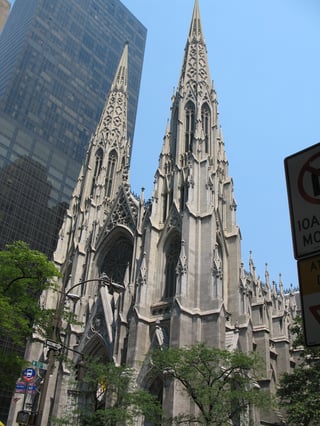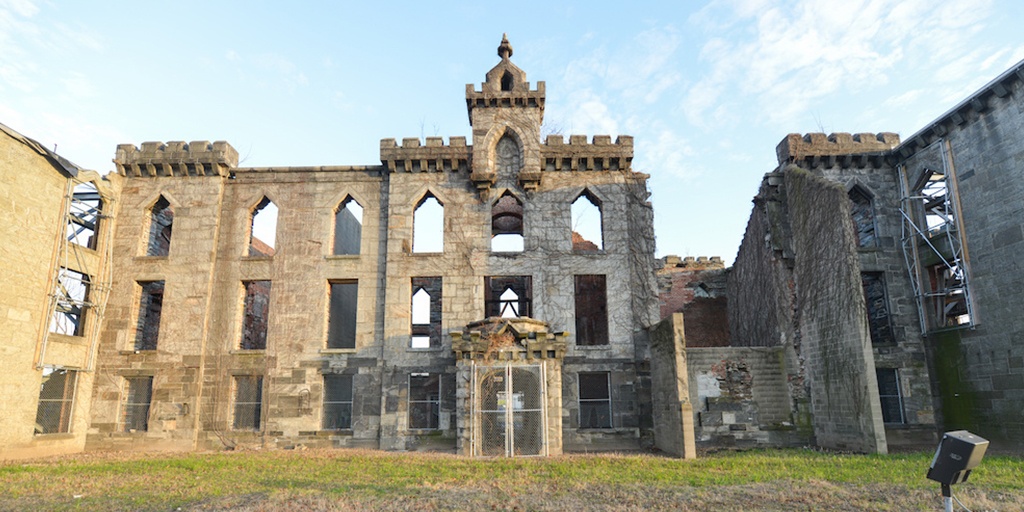As the summer schedule calms and the autumn weather begins to take over, make your way on the F train out to Roosevelt Island to see the Renwick Ruins. Just a short 15-minute stroll south of the Roosevelt stop, this crumbling, ivy-covered castle was built in the 19th century as the first major U.S. hospital dedicated to caring for smallpox victims. It now demands a closer look.
As we speak, the Renwick Ruins are on the cusp of a controversial change and potential adaptive reuse. This article provides an in-depth look at this fascinating building’s past, so you may help decide its future.
RENWICK RUINS IN THE PAST
Before they collapsed into disrepair, the Renwick Ruins were originally known as Smallpox Hospital, a three-story hospital designed by James Renwick, Jr. (known for St. Patrick’s Cathedral). The building was constructed of gray gneiss and featured Renwick’s famed Gothic Revival style. The castle-like structure may have been an unintentional homage to the history of the smallpox disease itself.
The Terrors of Smallpox
As modern people, it’s hard to understand exactly how awful smallpox was. During its height, smallpox killed more than 400,000 per year in Europe, including Louis XV of France. Queen Elizabeth I contracted the disease as a child and wore makeup to cover the disfiguring scars the disease left behind.
The virulence of smallpox led to the creation of the smallpox vaccine in 1796, which was the world’s first successful vaccine. Though the disease had a cure, most of the immigrants entering New York City in the 1800s had not been vaccinated. Infection levels were swiftly rising to epidemic proportions.
The contagious nature of smallpox necessitated strict quarantine during treatment. In 1850, NYC’s smallpox victims were housed in what Resident Physician William Kelly described as “a pile of poor wooden outhouses on the banks of the river.” 1800s hospitals were typically built for charity treatment, but the wide-ranging socioeconomic effects of smallpox required a solution that could accommodate paying patients as well as the poor.
The hunt was on for a suitable architect to design a creative solution.
James Renwick, Jr. – NYC’s Star Architect
 To entice New York City’s elite into using the hospital, the city chose one of their most fashionable architects, James Renwick, Jr., to head the project.
To entice New York City’s elite into using the hospital, the city chose one of their most fashionable architects, James Renwick, Jr., to head the project.
In 1843, 11 years before he designed Smallpox Hospital, Renwick had been a young, untested architect who had never gone to school and had never actually built anything. Luck was on his side though, and he achieved instant acclaim on his very first commission at the age of 25: Grace Church.
As one of the first Gothic Revival structures in NYC, Grace Church stood out – and as a clearly intelligent and eager-to-please young man, Renwick stood out too.
By 1846, Renwick won the competition for the design of the Smithsonian Institution Building in Washington, D.C., which was nicknamed “the Castle,” and later, Renwick went on to design the Gothic masterpiece St. Patrick’s Cathedral.
But before he completed St. Patrick’s, Renwick was selected to build Smallpox Hospital on what was then known as Blackwell Island (modern-day Roosevelt Island).
Photo Credit: Mr. Kjetil Ree under GFDL under CC-BY-SA-3.0
Smallpox Hospital
Designed in Renwick’s signature Gothic Revival style, the 100-bed Smallpox Hospital broke ground in 1854, built by patients from Blackwell Island’s lunatic asylum. When the building was nearing completion, a sudden fire in the treatment “outhouses” forced the transfer of patients to the hospital before it was completed. Nevertheless, Resident Physician William Sanger declared the place “admirable” and, on December 18, 1856, Smallpox Hospital officially opened as the first U.S. hospital dedicated to caring for smallpox victims.
Since the hospital was built for charity and paid patients, its design featured a large public ward on the lower level with the upper levels designated for private rooms.
The hospital treated approximately 7,000 patients per year, but as the resident population grew on Blackwell Island, smallpox victims were moved to a treatment facility on nearby uninhabited North Brothers’ Island. Smallpox Hospital was converted into a nurses’ dormitory in 1875.
An estimated 13,000 patients died at Smallpox Hospital. According to a park ranger at the neighboring Four Freedoms Park, the corpses would be stacked at the end of each floor, burned, and then dumped into the East River to prevent further infection.
The Post-Hospital Era
As a dormitory, the former hospital added the north and south wings from 1903-05 to hold additional beds for nurse trainees and nurses. Both wings were designed to match the original architecture. The only feature that was not inspired by Renwick’s Gothic Revival is the mansard roof with dormers.
By the 1950s, the island’s City Hospital (also designed by Renwick) required modernization and was moved to a new campus in Queens. The nurses’ dormitory was closed and the former Smallpox Hospital building swiftly fell into extreme disrepair.
THE RENWICK RUINS
In the late 1960s the structure had already become a ruin, but architectural historian Henry-Russell Hitchcock added it to a list of buildings to consider for Landmark status. The building was added to the National Register for Historic Places in 1972, and on March 23, 1976, the Landmarks Preservation Commission designated the ruins as an official New York City Landmark. It remains the city’s only landmark ruin.
That’s when the controversy began.
The city and Roosevelt Island residents knew that stabilizing the ruins would be a costly endeavor, so they left the ruins alone as they slowly considered their next actions.
According to the Renwick Ruins website and other sources, the next decades held various changes for the building:
- In the 1980s, junkies started a fire that gutted the building.
- In 1995, the ruins were illuminated with spotlights, creating the colorful nighttime sight from the Manhattan shoreline.
- By 1996, the city determined that it would require $3 million to stabilize the ruins.
- In 2005, the Trust for Public Land developed a plan to create the 7-acre South Point Park next to the Renwick Ruins. The plan included funds to stabilize the Ruins.
- On December 26, 2007, a wall of the Renwick Ruins collapsed in a blizzard.
- In 2008, engineers installed emergency shoring and bracing, and adaptive reuse plans were in favor of opening the ruins as a café. The cost of further stabilization rose to $7 million.
- On August 2, 2011, South Point Park opened for public use.
- In April 2012, the Renwick Ruins was named one of the Seven to Save endangered historic resources by the Preservation League of New York State.
- In 2013, a study found that permanent Ruins stabilization could cost $18 million.
During the long, drawn-out Renwick Ruins discussion, the city moved forward on plans to build the nearby Four Freedoms Park in honor of FDR. Four Freedoms Park contained its own 36-year-long saga, but it finally opened in 2012. The Park’s design reflected some elements of the Renwick Ruins’ picturesque beauty and brought the Ruins’s lagging preservation efforts back into the spotlight.
THE RENWICK RUINS IN THE FUTURE
.jpg?width=640&name=Ruins_of_the_Smallpox_Hospital_2007%20(2).jpg) Photo Credit: Skemez1 at English Wikipedia [Public domain], via Wikimedia Commons
Photo Credit: Skemez1 at English Wikipedia [Public domain], via Wikimedia Commons
The Renwick Ruins bring up an important consideration for today’s modern world. Since the 1800s, our society has recognized the importance of preserving our past, but with limited funds and increasing building decay, we need to decide what’s important to us – then move fast to act on our decisions.
Ten years ago, when a crumbling wall of the Renwick Ruins finally collapsed in a blizzard, it opened our eyes to how important the maxim of swift action was… yet now, a decade later, we still haven’t finalized plans for the Ruins.
According to a New York Times blog, preservationists in 2007 “expressed outrage and heartbreak that what should have been an 11th-hour rescue had turned instead into a last-minute crisis.” Peg Breen, president of the New York Landmarks Conservancy, called the collapse a “real failure of stewardship,” and exhorted the city to act faster in the future.
“They shouldn’t get by, saying, ‘We don’t have enough money’ or ‘It’s too late,’” said Breen. “They should bring in the cavalry and fix this important landmark.”
At the same time, Judith Berdy of the Roosevelt Island Historical Society raised an inspiring call to action, calling the Ruins “irreplaceable.... No one would have the budget [today] to put up a building like this [and] I don't know if there are any craftsmen who could put up a building like this anymore."
And now, finally, fast action is starting to take effect:
- Barely over one year ago, in July 2016, Roosevelt Islanders weighed in on their interests for the future of the Renwick Ruins, indicating that they’d prefer to stabilize the ruins, turn it into a museum, or turn it into a café.
- By December 2016, plans had moved forward to determine stabilization costs and economic feasibility reports for adding concessions opportunities.
- In July 2017, the Roosevelt Island Operating Commission applied to the Regional Economic Development Council for $670,000 to create schematic drawings for the Ruins’ stabilization.
You can help decide the future of this building.
As a city, we don’t want to erase history or art but we do need to think carefully about what we preserve and why. Though the Renwick Ruins are costly to maintain, they’ve also had an undeniable appeal for the past 161 years.
We’re not sure what the right choice is for the former Smallpox Hospital, but we know that this building has been a community anchor for more than a century and it forms the backbone of our connection to Roosevelt Island. Some people may hate the Ruins, some may love them, but it’s time for us to stand together and determine their future.
What will you do?
Sign up for more thought-provoking articles in your inbox when you subscribe to the Insights blog, all about NYC architecture.







